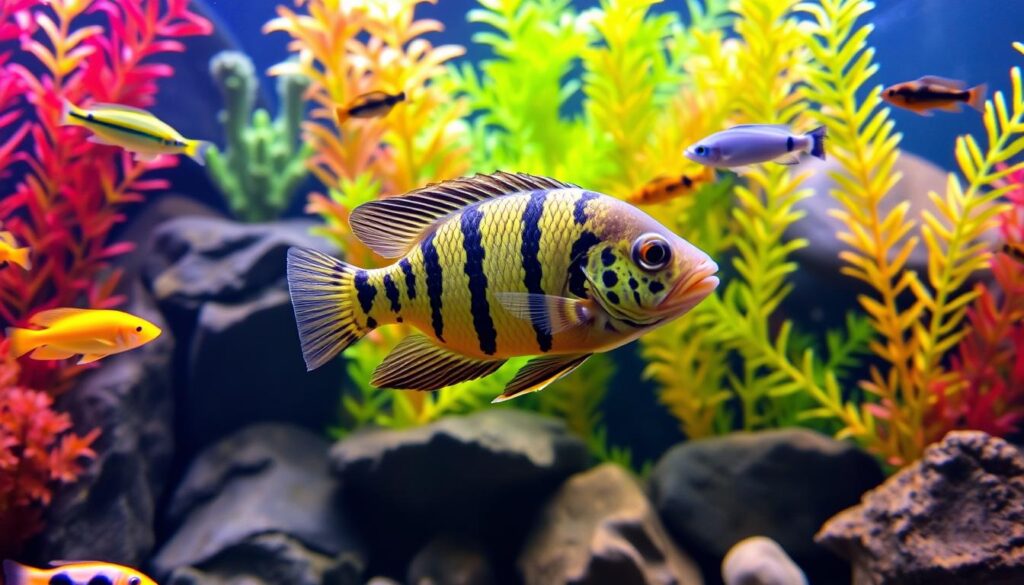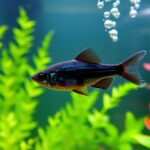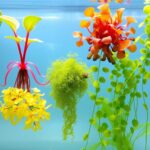Did you know the Agassiz Dwarf Cichlid can live in water as acidic as pH 3.0? This shows how adaptable these South American cichlids are. As a fan of nano aquariums, I love the Apistogramma agassizii for its bright colors and small size.
The Agassiz Dwarf Cichlid is named after Louis Agassiz, a Swiss-American zoologist. Males grow up to 3 inches, making them great for small tanks. Their bright yellows and unique horizontal stripe make them a popular choice for adding color to aquariums.
These fish come from the Amazon basin and are part of a diverse group of South American cichlids. The Apistogramma genus has about 70 known species, with more waiting to be discovered. This means hobbyists have many color morphs to choose from, making these fish a great addition to any tank.
Agassiz Dwarf Cichlids are not only beautiful but also easy to care for. They like water temperatures between 74-84°F and prefer slightly acidic conditions. Their small size makes them perfect for nano aquariums, but they do best in tanks of at least 15 gallons for a group.
Key Takeaways
- Agassiz Dwarf Cichlids are adaptable to extreme water conditions
- Males grow up to 3 inches, perfect for nano aquariums
- They belong to a diverse genus with about 70 known species
- Multiple color morphs are available in the aquarium trade
- A 15-gallon tank is suitable for a pair or small group
- They prefer slightly acidic water and temperatures of 74-84°F
Introduction to Apistogramma agassizii
I’m thrilled to introduce you to Apistogramma agassizii, a dwarf cichlid species that’s a favorite among aquarium lovers. This small fish is known for its bright colors and interesting behavior. It has won the hearts of people all over the world.
Scientific Classification
A. agassizii is a key part of the apistogramma taxonomy. It’s in the Cichlidae family and the Apistogramma genus, which has almost 100 species. Some experts think A. agassizii might actually be several different species. They believe this could have happened during the Plio-Pleistocene period.
Common Names and Variants
This species is also known as Agassiz’s dwarf cichlid and Agassiz ram cichlid. It comes in many beautiful colors, like Fire Red and Gold. The Fire Red and Gold variants are especially loved by aquarium fans. A. agassizii is easy to spot because of its round tail, which makes it stand out from other dwarf cichlids.
| Variant | Description | Popularity |
|---|---|---|
| Fire Red | Vibrant red coloration | High |
| Gold | Golden yellow hue | Medium |
| Standard | Natural coloration | Moderate |
Historical Background
The Agassiz ram cichlid has a long history in ichthyology. It was first described by Steindachner in 1875 as Geophagus agassizii. The name honors Louis Agassiz, a famous Swiss-American zoologist and geologist from 1807 to 1873. This small fish honors a giant of science, showing the big impact on our knowledge of nature.
Natural Habitat and Distribution
I’ve always been drawn to the variety of south american cichlids, especially the Apistogramma agassizii. These dwarf cichlids live in the amazon basin. They love the slow-moving waters and backwaters of the lush rainforest.
A. agassizii can be found from the upper Amazon in Peru to the Capim River in Brazil. They’re very adaptable, living in different water types, including the famous blackwater streams of the Amazon.
These fish like areas with little current and lots of hiding spots. In the wild, they hide among fallen leaves and plant debris. This helps them avoid predators and find the right places to breed.
| Characteristic | Details |
|---|---|
| Origin | Amazon basin (Northwestern Brazil and Peru) |
| Habitat | Slow-moving tributaries, backwaters |
| Water Types | Black, white, or clear water |
| Preferred pH | 5.0 – 7.0 |
| Temperature Range | 72 – 84°F (22 – 29°C) |
Knowing where A. agassizii come from helps us keep them happy in aquariums. By creating the right environment, we can see them act naturally and show off their colors.
Physical Characteristics of Agassiz Dwarf Cichlid
I’ve always been fascinated by the dwarf cichlid appearance, and the Agassiz Dwarf Cichlid is no exception. These tiny fish are a big deal for their looks and personality. Let’s explore their unique traits.
Size and Dimorphism
Agassiz Dwarf Cichlids show off amazing sexual dimorphism. Males can grow up to 7.5cm, while females reach 5cm. This size difference is just the start of their unique features.
Coloration and Patterns
The cichlid coloration of Apistogramma agassizii is stunning. Males have vibrant gold bodies with black stripes or spots. Some have a beautiful blue hue on their upper body and a yellow-gold belly. Females have a shimmering gold body that’s just as captivating.
Fin Structure
Males have more extended fins, especially during breeding season. These fins and their vivid colors make them stand out in any aquarium.
| Feature | Male | Female |
|---|---|---|
| Size | 7.5cm | 5cm |
| Coloration | Vibrant gold with black markings, sometimes blue | Shimmering gold |
| Fin Structure | Extended, especially during breeding | Standard |
These physical traits make Agassiz Dwarf Cichlids a favorite among aquarium fans. Their striking looks and interesting behaviors always catch my eye.
Behavior and Social Structure
Apistogramma agassizii, a type of cichlid, shows interesting behaviors. They like living in groups, with more females than males. This setup keeps peace in their group.
Male Apistogramma agassizii get very territorial when it’s time to breed. They protect their areas and act out in complex ways. But, they usually get along well in their group if they have enough space.

These fish are both territorial and peaceful with others. They can be mean to their own kind but are usually calm with other fish. This makes them great for community tanks with fish like tetras and small plecos.
They do more than just defend their territory. I’ve seen them perform special courtship dances and take care of their young. These actions show how complex their social lives are. This makes them popular among people who like peaceful fish with interesting social behaviors.
| Behavior Type | Description |
|---|---|
| Territoriality | Males establish and defend territories, especially during breeding |
| Social Structure | Thrive in groups with more females than males |
| Community Interaction | Generally peaceful towards other species |
| Breeding Behavior | Complex courtship displays and dedicated parental care |
Aquarium Requirements
Setting up a tank for Apistogramma agassizii dwarf cichlids needs careful thought. I’ll cover the basics of a small aquarium setup. This includes tank size, water conditions, and filtration.
Tank Size and Setup
I suggest a 20-gallon tank for a pair or trio of Agassiz’s dwarf cichlids. This size gives them enough room to claim territories and swim freely. It’s important to mimic their natural habitat for their health.
- Use soft, sandy substrate for bottom sifting
- Add plenty of hiding spots with caves and driftwood
- Include live plants for cover and water quality
- Incorporate leaf litter to mimic their native environment
Water Parameters
Keeping the right water conditions is key for Apistogramma agassizii. These fish need specific conditions that match their Amazonian roots:
| Parameter | Ideal Range |
|---|---|
| Temperature | 72-84°F (22-29°C) |
| pH | 5.0-7.0 |
| Hardness | Soft to moderately hard |
Filtration and Lighting
I use gentle filtration in my setup to prevent strong currents. Sponge filters or low-flow power filters are good choices. Dim lighting helps mimic their shaded natural habitat. I change the water weekly by 10-15% to keep it clean. For an authentic look, I add Indian almond leaves. They’re good for the fish too.
Diet and Feeding Habits
Understanding the diet of dwarf cichlids is key to keeping them healthy in aquariums. These fish love to eat small invertebrates, just like they do in the wild. They live in rivers and streams, where they find food near the bottom.
For feeding in aquariums, I suggest a varied diet to match their natural diet. Live and frozen foods should make up most of their meals. Great choices include:
- Artemia (brine shrimp)
- Daphnia
- Bloodworms
- Micro-worms
Even though Apistogramma agassizii are meat-eaters, adding high-quality cichlid pellets is good too. These pellets should be high in protein to help them get the nutrients they need.
| Food Type | Frequency | Benefits |
|---|---|---|
| Live/Frozen Foods | Daily | High protein, natural feeding behavior |
| Cichlid Pellets | 2-3 times per week | Balanced nutrition, convenient |
| Vegetable Matter | Occasionally | Fiber, vitamins |
Feeding these fish small amounts often works best. It keeps them well-fed and helps keep the aquarium water clean. A well-fed Apistogramma agassizii makes a beautiful addition to any tank.
Breeding Apistogramma agassizii
Breeding Apistogramma agassizii is rewarding for those who love dwarf cichlids. These fish become ready to breed around 6 months old. Their unique breeding behaviors make watching them fascinating.
Courtship Behavior
The courtship dance of A. agassizii is amazing. Males show off their bright colors and spread their fins to draw in females. Females pick the perfect cave for spawning, checking several before deciding.
Spawning Process
After picking a cave, the cichlids start spawning. Females lay up to 150 eggs at a time. These eggs stick to the cave walls and floor. Then, the female takes care of the eggs, and the male guards the area.
Fry Care
Taking care of the fry is key to successful breeding. The eggs hatch in 2-4 days, depending on the water’s warmth. Once free-swimming, the fry need special care. I start by feeding them infusoria and then baby brine shrimp as they grow. A 10-gallon tank with a soft filter is best for raising fry.
| Breeding Aspect | Details |
|---|---|
| Sexual Maturity | 6 months |
| Eggs per Batch | Up to 150 |
| Hatching Time | 2-4 days |
| Breeding Tank Size | 10 gallons |
Breeding A. agassizii takes patience and careful attention. With the right setup and care, you’ll soon have a thriving group of these lovely dwarf cichlids in your tank.
Compatibility and Tank Mates
Apistogramma agassizii is a great choice for peaceful community fish tanks. They are calm and can live with other small fish. When picking tank mates, think about size and how they act.
Good friends for Agassiz’s Dwarf Cichlid include small, peaceful fish from South America. Some top picks are:
- Neon Tetras (1-2.5 inches)
- Cardinal Tetras (2 inches)
- Pencilfish (up to 2 inches)
- Pygmy Corydoras (1 inch)
- Otocinclus Catfish (1-2 inches)

Don’t pair Apistogramma agassizii with big, mean fish or other dwarf cichlids that might fight over space. These cichlids are peaceful but might eat small shrimp as they get bigger.
| Compatible Tank Mates | Size (inches) | Temperament |
|---|---|---|
| Neon Tetra | 1-2.5 | Peaceful |
| Rasbora | Up to 4 | Peaceful |
| Pygmy Corydoras | 1 | Peaceful |
| Pencilfish | Up to 2 | Peaceful |
| Cardinal Tetra | 2 | Peaceful |
Apistogramma agassizii likes tanks of 20 to 30 gallons with lots of places to hide. Keep the water at 72-86°F and a pH of 6.0-7.0 for a happy home for your fish and their friends.
Conservation Status and Threats
I’m worried about the future of Apistogramma agassizii. This species is not listed by the IUCN yet, but it faces big challenges. The Amazon basin, where they live, is threatened by human activities.
Habitat loss is a big problem for Apistogramma agassizii. Deforestation in the Amazon is destroying their homes fast. They need specific water conditions to live, with ideal pH levels between 4.0 and 6.5. Changes in their environment can greatly harm their numbers.
Overfishing for the aquarium trade is another big threat. These cichlids are loved for their bright colors and small size (up to 7.5 cm). But, taking them out of the wild too much can quickly reduce their numbers.
Climate change is a long-term danger for Apistogramma agassizii. They like temperatures between 72-84°F (22-29°C). If global temperatures keep rising, it could make their lives harder, affecting their breeding and survival.
We need to work on cichlid conservation. Protecting their homes and promoting sustainable collection is key. Supporting efforts to save the Amazon can help these beautiful fish survive for years to come.
“Every effort towards preserving the Amazon’s biodiversity counts. Even small actions can make a big difference for species like Apistogramma agassizii.”
Popular Aquarium Morphs and Varieties
I’ve seen some stunning cichlid color morphs in the aquarium trade. Selective breeding has produced an array of beautiful Apistogramma agassizii varieties. These aquarium fish varieties offer diverse options for enthusiasts looking to add a splash of color to their tanks.
The ‘Double Red’ morph is one of my favorites. It has fiery reddish-orange fins and tail that really stand out in a well-planted aquarium. The ‘Fire Red’ morph is bold, with no stripe, and the ‘Super Red’ has vivid body colors.
Blue lovers aren’t left out either. The ‘Blue Flame’ morph has a metallic blue body that shines under aquarium lights. The ‘Cuipeua’ variety combines a yellow belly with a striking blue back.
| Morph | Distinguishing Features |
|---|---|
| Double Red | Fiery reddish-orange fins and tail |
| Fire Red | Lacks characteristic stripe |
| Super Red | Intense body coloration |
| Blue Flame | Metallic blue body color |
| Cuipeua | Yellow belly and blue back |
These varieties offer a rainbow of choices while maintaining the species’ desirable traits. It’s amazing how selective breeding has expanded the palette of these fascinating dwarf cichlids.
Conclusion
Apistogramma agassizii is a captivating dwarf cichlid for those who love nano aquarium fish. They grow up to 3 inches and do well in tanks as small as 20 gallons. They like their water to be between 6.0-7.5 pH and 72-84°F (22-29°C).
It’s important to take good care of these fish. They can live up to 5 years with the right care. Breeding them is rewarding, with eggs hatching in 3-5 days. Studies on related species have shown interesting things about their populations and how we can help them.
Learning more about Apistogramma agassizii shows how vital it is to protect their homes. Research on Apistogramma gephyra and A. pertensis shows how changes in the environment affect them. Scientists have found important information on their genetic diversity and how they live together.
In conclusion, Apistogramma agassizii is a special fish for aquarium lovers. Their bright colors and fun behaviors make them perfect for small tanks. By knowing what they need and helping to protect them, we can make sure they keep doing well in the wild and in our homes.
FAQ
What is the natural habitat of Apistogramma agassizii?
What are the ideal tank conditions for keeping Apistogramma agassizii?
What do Apistogramma agassizii eat?
How do Apistogramma agassizii breed?
What are some suitable tank mates for Apistogramma agassizii?
What are some popular color morphs of Apistogramma agassizii?
What are the conservation threats facing Apistogramma agassizii?
Source Links
- Apistogramma agassizii | Dwarf Cichlid Care & More – Maryland Aquarium Design, Installation, and Maintenance
- Apistogramma agassizii (Agassizi’s Dwarf Cichlid) — Seriously Fish
- Apistogramma agassizii
- Care Guide for Apistogramma Dwarf Cichlids — Housing, Breeding, & More
- Apistogramma agassizii summary page
- Apistogramma Agassizii Care Guide | Practical Aquariums
- Apistogramma Care 101 (aka Dwarf Cichlid)
- Agassiz’s Dwarf Cichlid – Apistogramma Agassizii
- Apistogramma Agassizii Profile Fish – Day Pets
- Frontiers | River Reorganization Affects Populations of Dwarf Cichlid Species (Apistogramma Genus) in the Lower Negro River, Brazil
- Apistogramma agazzi – Agassiz’s dwarf cichlid | Dwarf Cichlids
- Agassiz’s Apistogramma – Apistogramma agassizii Fish Profile & Care Guide
- Apistogramma: Complete Knowledge and Care Guide for Dwarf Cichlids
- Amazon Dwarf Cichlid – Apistogramma pertensis Fish Profile & Care Guide
- Care Guide for Apistogramma Dwarf Cichlids — Housing, Breeding, & More
- Agassiz’s Apisto-Apistogramma agassizii
- Harmonious Haven: Apistogramma Tank Mates Unveiled🐠| Fish Lab
- What Are the Best Cichlids for a Community Tank? – RateMyFishTank.com
- Best dwarf cichlid species for a peaceful aquarium – Aquadecor
- Agassiz’s Apistogramma – Fire Red – Apistogramma agassizii var. "Fire Red" Fish Profile & Care Guide
- Apistogramma agassizii summary page
- Care Guide for Apistogramma Dwarf Cichlids — Housing, Breeding, & More
- 28 Apistogramma Types – Different Varieties of Apistogramma
- ‘Golden Fire Red’ Agassizii’s Dwarf Cichlid – Planted Aquaria – Bring Nature Home


